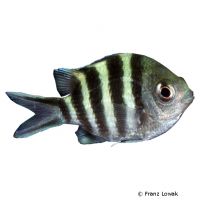Scissortail Sergeant (Abudefduf sexfasciatus)
| Scissortail Sergeant Abudefduf sexfasciatus | |
|---|---|
| Name | Scissortail Sergeant |
| Name Lat. | Abudefduf sexfasciatus |
| Family | Damselfishes |
| Family lat. | Pomacentridae |
| Order | Ovalentarias |
| Order lat. | Ovalentaria inc. sed. |
| Origin | Indo-West Pacific, Red Sea |
| Habitat | Reefs |
| Diet | Omnivore |
| pH | 8.1-8.4 |
| Hardness | 8-10 °KH |
| Behavior | Territorial |
| Keeping | Individual, group |
| Reef Compatible | Yes |
| Care Level | Moderate |
| Life Span | 2-5 years |
| Protection | No |
| Metric Units | |
| Size | 14 cm |
| Temperature | 22-28 °C |
| Salinity | 33-36 ‰ |
| Aquarium | ~ 500 l |
| US Units | |
| Size | 6" |
| Temperature | 72-82 °F |
| Salinity | 1.020-1.025 sg |
| Aquarium | ~ 130 gal |
Distribution and habitat
The distribution area of Abudefduf sexfasciatus is the Red Sea, the Indian Ocean from the East African coast to Indonesia and the Western Pacific from South Japan to Australia. They live there mostly in small groups on inner and outer reefs with soft coral growth up to 20 m depth as well as in the intertidal zones above the reef tops in shallow water.
Maintenance
They require a well-structured aquarium with a reef structure that allows for territoriality and at the same time provides hiding, resting and cover opportunities, with live stones that act as a biological filter and sufficient swimming space. Only lime-rich, heavy metal-free sands, gravels, stones or sea sand of various grain sizes may be used as substrate
Filters, skimmers and heaters are necessary to ensure water quality, as well as pumps to simulate tides, swells and bottom currents. Lighting must correspond to the species-appropriate day-night rhythm of the animals
| Salinity: 33-36 ‰ | pH value: 8.1-8.4 |
| Carbonate hardness: 8-10 °KH | Nitrate content: 2-8 mg/l |
| phosphate content: 0.01-0.1 mg/l | nitrite content: 0.0-0.05 mg/l |
For salinity, an average value should be aimed for, which may only vary slightly by +/- 0.5 ‰. Ammonia and ammonium must not be measurable. Special attention must be paid to constantly good water quality.
Diet
They feed mainly on zooplankton, but also need plant food. The feed change usually succeeds without problems. The food supply should consist of a combination of small krill, mysis and artemia as well as commercially available, frozen special food mixtures and algae (e.g. spirulina, kelp). High-quality dry food in flake or granule form with a high vegetable content is also well accepted. It is recommended to feed small portions several times a day (3-5 times)
Regular and varied feeding promotes health and prevents deficiency symptoms.
Behaviour and compatibility
It is recommended to keep them individually or better in a group of several animals. To avoid territorial fights, they should be placed in the aquarium at the same time. Adults behave very territorial, therefore keeping several animals is recommended only in a larger and richly structured tank. Towards smaller fish and fish of the same size they usually behave aggressively and consistently defend their territory.
Sex dimorphism
There are no known external distinguishing characteristics.
Reproduction and breeding
They could already be bred several times in the aquarium.
Important
As coral reef dwellers, they should not be maintained in a fish-only aquarium
If different species are kept together, care should be taken to ensure that the fish match each other in terms of water quality and temperature requirements and social behavior, and that the setup meets the needs of all species kept together. New fish to be introduced must be acclimated slowly to the water in the aquarium.
Further literature can be found in your pet store.
References
Text: Werner Winter; Image: Franz Lowak
Source: KUITER, DEBELIUS (2007): Atlas der Meeresfische: Die Fische an den Küsten der Weltmeere, Kosmos Verlag; ENGELMANN (2005): Zootierhaltung - Tiere in menschlicher Obhut: Fische, Verlag Harri Deutsch
- Gemäß § 21 Abs. 5 Tierschutzgesetz idgF
